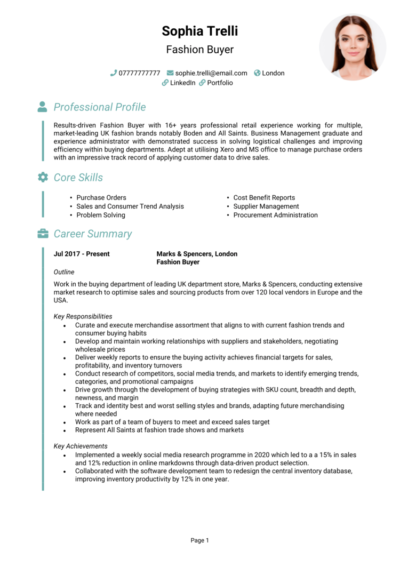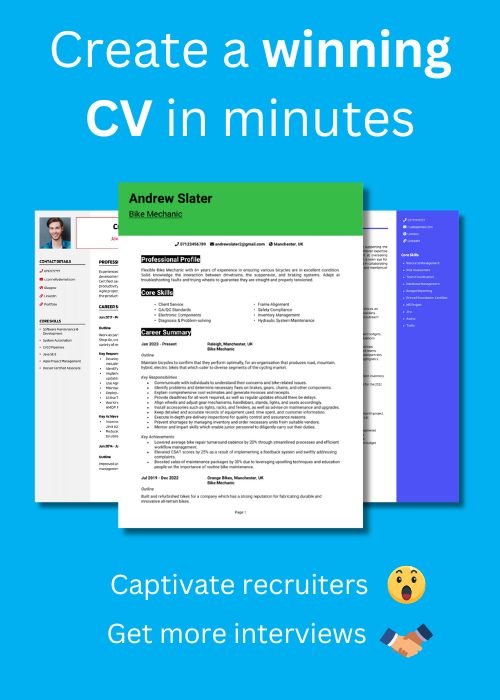In fashion, timing is everything – and the same goes for your next move. If you’re planning to switch brands or step up a level (or just refresh your look on paper), your CV needs to reflect the value you bring to every buying decision.
This guide and its Fashion Buyer CV example will help you create an application that doesn’t just showcase your eye for detail and instinct for what sells – it proves to hiring managers that you’ve got the experience and commercial insight to drive sales and deliver genuine results.
Fashion Buyer CV
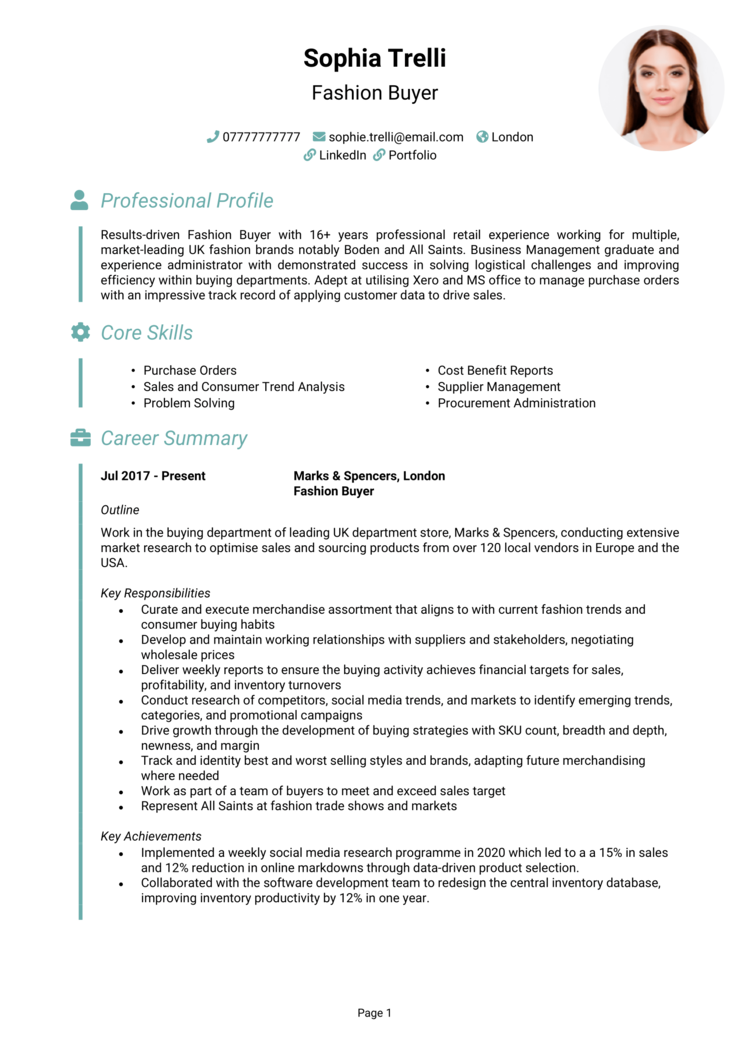
How to write your Fashion Buyer CV
Discover how to craft a winning Fashion Buyer CV that lands interviews with this simple step-by-step guide.
Hiring managers don’t just want a fashion enthusiast – they want someone who knows how to buy what sells and negotiate smartly. Your CV needs to make that case in under 30 seconds.
This guide will take you through the full process: from writing a CV in the right order to tailoring each section in a way that reflects your market understanding and brand alignment. If it’s done well, your CV will be as curated and commercially driven as the product mix you’re used to shaping.
What’s the right way to structure and format your Fashion Buyer CV?
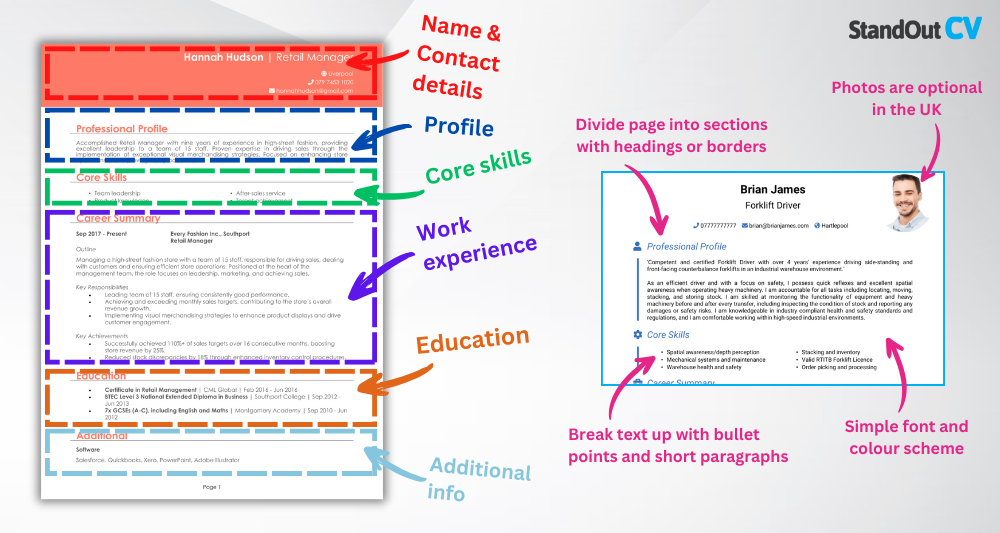
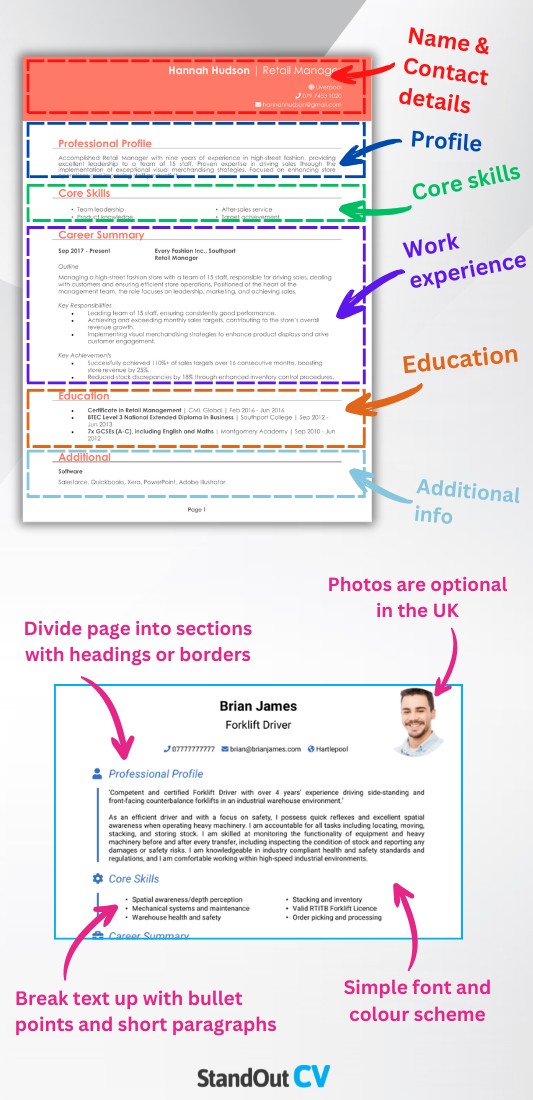
Your CV isn’t just a list – it’s a product in itself. And like any good range plan, it needs structure and strong visual organisation. If the formatting is confusing or full of mistakes, a recruiter won’t wait around to work out what’s where – they’ll just move on to the next candidate.
Here’s the layout to follow:
- Name and contact details – Display your personal details clearly at the top so employers can get in touch easily. Including a photo is entirely optional.
- Profile – Begin with a concise summary that highlights your expertise and what you bring to the role.
- Core skills – Highlight your strongest skills that align with the role’s requirements.
- Work experience – Start with your most recent role and work backwards, showcasing achievements and responsibilities.
- Education – Mention your degrees, certifications, and any training that supports your career path.
- Additional info – Include any additional details, like awards, professional memberships, or hobbies that highlight your skills or personality.
Make use of bullet points to keep everything skimmable and clear, and divide your CV into neatly labelled sections with consistent headings. Choose a clean, stylish font – nothing too fussy – and give each section breathing space. Keep the whole document length under two pages, and resist the urge to overdecorate. Treat your CV format the same way you’d treat a buyer’s report.
How to create a Fashion Buyer CV profile


This section sits right at the top – and it needs to make the right first impression. Use it to show that you understand both the creative and commercial side of fashion buying, and that you can balance trend awareness with margin goals and stock turnover.
Your CV profile is your first chance to hook recruiters, so make sure you pack it with enough information to show your value, without overwhelming or boring the reader.
Fashion Buyer CV profile examples
Profile 1
Experienced Fashion Buyer with over 12 years in luxury retail and high-street fashion, managing seasonal buying strategies across multiple product categories. Skilled in supplier negotiations, range planning, and sales forecasting to maximise profitability and market appeal. Proficient in using retail analytics tools such as Tableau and merchandising systems like JDA. Known for balancing creative trend insight with strong commercial acumen to deliver collections that drive sales growth and brand positioning.
Profile 2
Strategic Fashion Buyer with seven years of experience in e-commerce and fast-fashion environments. Oversaw end-to-end buying processes, from trend analysis and supplier sourcing to final product launches. Experienced in working with global supply chains, negotiating costs, and maintaining brand consistency across digital platforms. Adept in using PLM systems and sales analytics to inform decisions and optimise stock levels.
Profile 3
Ambitious Fashion Buyer with three years of experience in a boutique womenswear brand, supporting the buying team with trend research, sample management, and vendor coordination. Assisted in creating cohesive seasonal collections while tracking performance through sales data. Comfortable using Excel, fashion PLM software, and digital mood board tools to streamline the buying process. Passionate about identifying new talent and emerging fashion trends.
Details to put in your Fashion Buyer CV profile
Here’s what to include:
- Where you worked – Mention the types of retailers or brands you’ve worked with, and whether they were high street, luxury, e-commerce, or department stores.
- Your top qualifications – Include any fashion-related degrees or business certifications that support your buyer expertise.
- Essential skills – Briefly highlight the core strengths you bring to a fashion buying role – such as trend analysis, supplier management, or forecasting.
- Teams or departments supported – Note the functions you collaborated with, such as design, merchandising, marketing, or VM.
- Value delivered – Explain how your work contributed to commercial success – increased sell-through, reduced markdowns, or improved supplier terms.
Presenting your core skills


As a buyer, your strongest assets are your ability to analyse data, spot trends, negotiate prices, and forecast demand. This section is where you underline those strengths – but only the ones that align with the job you’re applying for.
Tailor your CV skills to reflect what’s asked for in the job advert. Steer clear of vague terms or filler here – focus on hard, tangible skills that reflect your decision-making and commercial acumen.
Essential skills that recruiters look for in a Fashion Buyer CV
- Trend Analysis and Forecasting – Researching emerging fashion trends, consumer preferences, and seasonal shifts to inform buying decisions.
- Range Planning and Selection – Curating product ranges that align with brand identity, target market, and sales strategy.
- Supplier Sourcing and Negotiation – Building relationships with designers and manufacturers, negotiating prices, lead times, and order quantities.
- Sales and Stock Performance Analysis – Monitoring sell-through rates and analysing data to optimise product selection and stock levels.
- Budget Management and Margin Control – Managing seasonal budgets and ensuring product selections meet profit margin targets.
- Sample Review and Quality Assessment – Evaluating product samples for design, fit, fabric, and quality before confirming orders.
- Seasonal Buying Trips and Trade Show Visits – Attending fashion weeks, trade fairs, and showrooms to discover and select new collections.
- Product Lifecycle and Timing Management – Scheduling product drops and coordinating with merchandising and logistics for timely delivery.
- Collaboration with Design and Merchandising Teams – Working closely with internal teams to ensure cohesive collections and visual presentation.
- Competitor and Market Research – Tracking competitor activity and consumer demand to maintain competitive edge and relevance.
How to highlight work experience


You’re applying for a role that depends on results – so this section should show the impact of your decisions, not just your job duties. If you influenced revenue, improved product sell-through, or launched a new line that outperformed expectations, this is the place to shout about it. A useful tip is to sprinkle in some numbers wherever possible.
List your previous roles in reverse chronological order. Open each work experience entry with a short paragraph summarising your role and the type of business you worked for. Then break down the key duties and results using bullet points – and keep each point sharp and outcome-focused.
How to make your past experience easy to read for employers

- Outline – Give context on the brand or company and the scale of your buying responsibilities. Mention what kind of ranges you worked on and who you reported to.
- Responsibilities – Use action words like “selected” and “negotiated.” For example: “selected seasonal ranges aligned with sales trends” or “negotiated with overseas suppliers to improve margins.”
- Achievements – Include clear commercial results where you can – such as reduced excess stock, improved full-price sell-through, or successful launches of exclusive collections.
Example job entries for Fashion Buyers
Fashion Buyer | Harrington & Vale Department Stores
Outline
Managed seasonal buying for womenswear and accessories across a nationwide department store chain. Worked with international suppliers and luxury labels to deliver collections tailored to customer demand and market trends.
Responsibilities
- Developed seasonal buying plans in alignment with sales forecasts and budgets
- Negotiated prices, lead times, and exclusivity agreements with suppliers
- Analysed sales data to monitor product performance and adjust buying strategy
- Travelled to trade shows and fashion weeks to source new collections and emerging designers
- Collaborated with merchandising and marketing teams to plan launches and promotions
Achievements
- Increased seasonal sales revenue by 18% through refined buying strategy
- Secured exclusive partnerships with three European fashion labels
- Reduced end-of-season markdowns by 20% through improved stock forecasting
Fashion Buyer | Vireo Online Fashion
Outline
Oversaw trend-led buying for a fast-fashion e-commerce retailer with a global customer base. Ensured rapid product turnover and market responsiveness by coordinating with overseas suppliers and in-house design teams.
Responsibilities
- Tracked and analysed competitor trends and online sales performance
- Planned weekly product drops in line with customer demand and fast-fashion cycles
- Sourced fabrics and trims from international suppliers for in-house design ranges
- Approved samples and ensured quality standards met brand requirements
- Maintained close relationships with logistics teams to manage lead times
Achievements
- Improved product sell-through rate to 85% within first season by tightening trend forecasting
- Negotiated supplier terms that cut production costs by 12% without quality compromise
- Launched a sustainable capsule range that accounted for 10% of seasonal sales
Fashion Buyer | Elmwood Boutique Collective
Outline
Worked for an independent womenswear and lifestyle boutique group, curating collections from emerging designers and artisan brands. Focused on niche, high-quality products that aligned with the company’s brand ethos and customer base.
Responsibilities
- Researched new designers and attended trade shows to identify unique pieces
- Coordinated with small-scale suppliers and ensured timely delivery of collections
- Analysed sales data to identify bestsellers and refine future buying decisions
- Worked with visual merchandisers to create engaging in-store displays
- Managed sample inventory and arranged fittings for promotional photo shoots
Achievements
- Boosted boutique sales by 22% through curated collections tailored to local demand
- Introduced 15 new independent designers into the store portfolio
- Helped secure industry recognition with a regional retail award for best curation
Education and qualifications


Fashion buyers come from a variety of academic backgrounds – and while formal qualifications aren’t everything, they’re still useful to include. Focus on your most relevant education, such as fashion degrees or courses in business.
List your most recent qualification first and include the course title, institution, and year of completion. If you’ve done short courses in fashion merchandising or data analysis, those are well worth including too – especially if they help bridge any gaps between your creative and analytical skills.
Qualifications recruiters look for in a Fashion Buyer
- BA in Fashion Buying & Merchandising – Directly relevant degree showing strong foundation in buying
- Diploma in Buying and Range Planning (Fashion Retail Academy) – Provides key buying techniques and industry insight
- BA or BSc in Fashion Management or Retail Marketing – Combines commercial understanding with fashion knowledge
- CIPS Certificate (Chartered Institute of Procurement & Supply) – Valuable if your role includes complex supply chain management
- Short Courses in Trend Forecasting (e.g. WGSN, LCF) – Shows you stay ahead of the curve and invest in trend literacy


